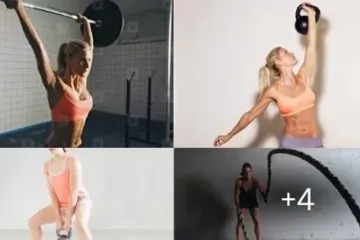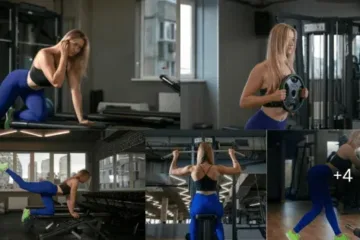Creating a powerlifting gym requires careful planning and selecting the right equipment to cater to the needs of serious lifters. Unlike general fitness gyms, a powerlifting gym must focus on the essentials that support heavy lifting, durability, and safety. Here’s a detailed guide on the essential equipment you need to set up a powerlifting gym, from bars to platforms.

1. Powerlifting Bars
The foundation of any powerlifting gym is the barbell. However, not just any barbell will do. Powerlifting bars are designed to handle extremely heavy weights and must have specific characteristics:
- High Tensile Strength: Look for bars with a high tensile strength rating (200,000 PSI or higher) to ensure they can withstand heavy loads without bending.
- Knurling: The grip pattern, or knurling, should be aggressive enough to ensure a firm grip during heavy lifts but not so harsh that it tears the skin.
- Center Knurl: Powerlifting bars typically have center knurling to provide extra grip during squats.
- Whip: The bar should have minimal whip (flexibility) to maintain stability during heavy lifts.
Top brands like Rogue, Eleiko, and Texas Power Bars offer excellent options specifically designed for powerlifting.
2. Power Racks
A sturdy power rack is a cornerstone of a powerlifting gym. It allows for safe and effective execution of squats, bench presses, and other lifts. Key features to look for include:
- Heavy-Duty Construction: The rack should be built from thick steel tubing and have a high weight capacity (1,000 lbs or more).
- Safety Pins or Straps: These are crucial for catching the bar if you fail a lift, preventing injury.
- Adjustable J-Hooks: These hold the barbell and should be easily adjustable to accommodate different exercises and lifter heights.
- Pull-Up Bar: Many power racks include a pull-up bar for additional versatility.
Popular models include the Rogue R-3 Power Rack and the Titan T-3 Series Power Rack.
3. Weight Plates
Quality weight plates are essential for any powerlifting gym. There are several types to consider:
- Cast Iron Plates: Durable and cost-effective, cast iron plates are a staple in many powerlifting gyms.
- Bumper Plates: Made from dense rubber, bumper plates are ideal for deadlifts and Olympic lifts, as they can be safely dropped without damaging the floor.
- Calibrated Plates: These are highly accurate and typically used in competitions. They ensure precise loading of the barbell.
Ensure you have a wide range of weights, from 2.5 lbs to 45 lbs, to accommodate all lifting levels.
4. Deadlift Platform
A deadlift platform is crucial for protecting your gym floor and equipment. It also provides a stable surface for lifting. Key components include:
- Rubber Mats: These absorb impact and reduce noise when dropping weights.
- Wooden Center: Provides a solid, non-slip surface for lifting.
- Frame: A metal frame can add extra stability and define the lifting area.
You can purchase pre-made platforms or build your own using rubber mats and plywood.
5. Benches
A high-quality bench is essential for bench pressing and other seated or lying exercises. Look for:
- Stability: The bench should have a sturdy frame and non-slip feet to prevent movement during lifts.
- Adjustability: An adjustable bench allows for flat, incline, and decline positions, adding versatility.
- Padding: Firm, high-density foam padding ensures comfort and support.
Brands like Rogue and Rep Fitness offer reliable benches designed for heavy lifting.
6. Chalk and Chalk Stand
Chalk helps improve grip by reducing moisture on your hands. A dedicated chalk stand keeps the gym clean and ensures chalk is always available. Consider a stand with a bowl to contain the mess and a storage compartment for extra chalk.
7. Belts and Straps
While not gym equipment per se, lifting belts and straps are essential accessories for powerlifters:
- Lifting Belts: Provide lower back support and help maintain proper form during heavy lifts.
- Lifting Straps: Assist with grip during heavy deadlifts or rows.
Offer a variety of sizes and styles to accommodate different lifters.
8. Specialty Bars
In addition to standard powerlifting bars, specialty bars can add variety and target different muscle groups:
- Safety Squat Bar: Designed to reduce shoulder strain and improve posture during squats.
- Hex Bar (Trap Bar): Great for deadlifts and shrugs, placing less strain on the lower back.
- Cambered Bar: Offers a different angle for squats and bench presses, challenging the muscles differently.
9. Plate Storage
Keeping your gym organized is crucial for safety and efficiency. Plate storage solutions include:
- Plate Trees: Compact and easy to move, ideal for storing weight plates of all sizes.
- Wall-Mounted Racks: Save floor space and keep plates easily accessible.
10. Flooring
Proper flooring is essential to protect both your equipment and your gym floor. High-density rubber flooring is ideal for powerlifting gyms. It absorbs impact, reduces noise, and provides a non-slip surface for lifting.
11. Mirrors
While not essential for lifting, mirrors can be very useful for checking form and technique. Proper form is crucial in powerlifting to prevent injuries and maximize performance. Large, wall-mounted mirrors placed strategically around the gym can help lifters self-correct their posture and movements.
12. Timer and Clock
A visible timer or clock helps lifters keep track of their rest periods and stay on schedule. This is particularly useful during timed circuits or when following a strict training regimen.
13. Conditioning Equipment
While powerlifting focuses on strength, incorporating conditioning equipment can enhance overall fitness. Consider adding:
- Battle Ropes: Great for high-intensity interval training (HIIT) and improving cardiovascular fitness.
- Kettlebells: Versatile for a variety of exercises, from swings to goblet squats.
- Rowing Machines: Excellent for full-body conditioning and cardio.
14. First Aid Kit
Safety should always be a priority in any gym. A well-stocked first aid kit is essential for handling minor injuries or emergencies. Ensure it includes bandages, antiseptics, ice packs, and other basic medical supplies.
15. Music System
A good sound system can enhance the gym atmosphere and motivate lifters. Invest in a durable, high-quality music system that can withstand the gym environment. Consider installing speakers around the gym for even sound distribution.
Conclusion
Setting up a powerlifting gym requires a thoughtful selection of equipment to ensure the safety, efficiency, and effectiveness of the training environment. From high-quality powerlifting bars and racks to specialty bars and conditioning equipment, each piece plays a crucial role in supporting the needs of serious lifters. By investing in the right equipment and maintaining a well-organized and safe gym, you can create an ideal space for powerlifters to train and achieve their goals. Whether you’re starting a commercial gym or a home setup, focusing on these essentials will set you on the path to success.





